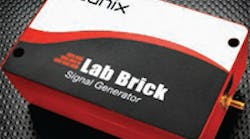Signal generators are essential to high-frequency testing. They vary greatly in sophistication, but for many tests, a simple source that provides clean output signals over a broad frequency range is all that is needed. The LMS-203 Lab Brick signal generator from Vaunix Technology Corp. is such a signal generator, offering fast-switching output signals from 10 to 20 GHz. The company also offers a series of octave-band USB signal generatorsincluding the model LMS-163, with frequency coverage from 8 to 16 GHz.
The LMS-203 (see figure) is the company's highest-frequency signal generator, powered and controlled by a Universal Serial Bus (USB) connection to a personal computer. The generator can also be powered by battery or remote power supply and operated under local control, making it suitable for such requirements as in-field testing. Although measuring just 4.90 x 3.14 x 1.59 in. (124 x 80 x 40 mm) and weighing less than 1 lb. (less than 0.45 kg), this is a full-performance signal generator, capable of better than +10 dBm output power across its 10-GHz frequency range. Output levels can be set as low as -30 dBm with 0.5-dB resolution. The output level accuracy is 0.75 dB at +10 dBm and 2.0 dB across the full 40-dB dynamic range. Frequency can be set with 100-kHz tuning resolution and 2 PPM accuracy. It also delivers tuning speed of 100 μs.
The LMS-203 can also perform a phase-continuous linear frequency sweep over its full band or over any portion thereof. It can perform upward, downward, or bidirectional frequency sweeps, with sweep times adjustable from 1 ms to 1000 s. The USB signal generator exhibits single-sideband phase noise of -83 dBc/Hz offset 10 kHz from any carrier from 10 to 20 GHz. Spurious levels are no greater than -70 dBc and typically -80 dBc. Harmonic levels are typically -40 dBc while subharmonic levels are typically -25 dBc. The LMS-203 is equipped with its own 10-MHz (crystal oscillator) frequency reference source, but can also be connected to an external 10-MHz frequency reference with greater stability for improved performance.
The USB signal source is available with optional pulse modulation for internal or external triggering, featuring typical rise/fall time of 30 ns and minimum pulse width of 100 ns. Pulses can be set with 100 ns and achieve pulse repetition intervals (PRIs) equal to the minimum pulse width plus 100 ns (minimum of 200 ns). External triggering can be performed over a trigger range of 0 to 5 V, also providing minimum pulse width of 100 ns.
Each LMS-203 is supplied with a 3-ft. USB cable and a USB flash drive containing graphical-user-interface (GUI) software and digital version of the programming guide. The Windows-compatable software can track and control several connected signal generators, simplifying multiple-signal test setups. The LMS-203 also contains internal memory, allowing it to store settings and come to a specific instrument state when powered on.
When lower-frequency operation is required, the LMS-163 offers similar performance from 8 to 16 GHz. It achieves phase noise of -84 dBc/Hz offset 10 kHz from any carrier from 8 to 16 GHz, with better than +10 dBm output power across the full range. Its frequency tuning and amplitude control capabilities match those of the LMS-203. Both signal generators draw about 600 mA current from a USB source. Either one is suitable for automatic-test-equipment (ATE) applications, whether by using an available programming guide or with the aid of commercial ATE software, such as LabView from National Instruments. Both comply with international requirements for electromagnetic-compatibility (EMC) emissions and immunity for Class A Industrial-Scientific-Medical (ISM) devices.
Vaunix Technology Corp.
242 Neck Road
Haverhill, MA 01835
(978) 662-7839
FAX: (978) 662-7842
e-mail: [email protected]

